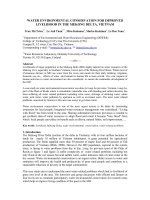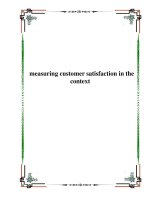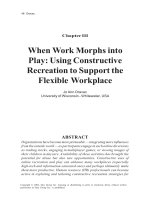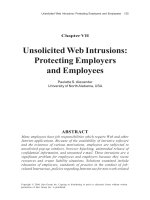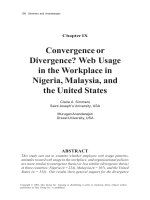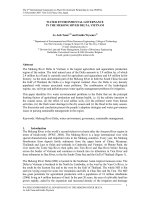Tài liệu Water environmental governance in the Mekong delta, Vietnam ppt
Bạn đang xem bản rút gọn của tài liệu. Xem và tải ngay bản đầy đủ của tài liệu tại đây (328.2 KB, 6 trang )
The 2
nd
International Symposium on Water Environment Partnership in Asia (WEPA).
3-4 December 2007. New Life Plaza, Oita, Japan
================================================================================
============================================================================
WATER ENVIRONMENTAL GOVERNANCE IN THE MEKONG RIVER DELTA
Le Anh Tuan and Guido Wyseure
1
WATER ENVIRONMENTAL GOVERNANCE
IN THE MEKONG RIVER DELTA, VIETNAM
Le Anh Tuan
1,2)
and Guido Wyseure
2)
1)
Department of Environmental and Water Resources Engineering, College of Technology
Can Tho University, Campus II, Street 3/2, Can Tho City, Vietnam
E-mail:
2)
Division for Land and Water Management, Faculty of Bioscience Engineering
Katholieke Universiteit Leuven, B-3001 Heverlee, Belgium
E-mail:
Abstract
The Mekong River Delta in Vietnam is the largest agriculture and aquaculture production
region of the nation. The total natural area of the Delta amounts to 3.9 million ha, of which
2.4 million ha of land is currently used for agriculture and aquaculture and 0.4 million ha
for
forestry. As the most downstream part of the Mekong River to both the South China Sea and
the Gulf of Thailand,
the Delta is a large tropical wetland. Also, the Delta is very densely
populated with intense associated water pollution. The combination of the hydrological
regime, sea, soil-type and pollution poses water quality management problems for irrigation.
This paper identifies five water environmental problems in the Delta that are the principal
limiting factors of agricultural production and human health, i.e. (i) the salinity intrusion in
the coastal areas, (ii) the effect of acid sulfate soils, (iii) the polluted water from human
activities, (iv) the fresh water shortage in the dry season and (v) the flood in the rainy season.
The discussion and conclusion present the people’s adaption strategies and water gorvernance
issues in pursing sustainable management in the region.
Keywords: Mekong River Delta, water environment, governance, sustainable management.
1. Introduction
The Mekong River is the world’s second richest river basin after the Amazon River region in
terms of biodiversity (WWF, 2004). The Mekong River is a large international river with
special characteristics and important roles in the Mekong countries. Every year, the Mekong
floodwaters from deposit fertile sediments from the upper basin of China, Myanmar,
Thailands and Laos to fields and wetlands in Cambodia and Vietnam. At Phnom Penh, the
river meets the Tonle Sap River, then splits into Tien River and Hau River before flowing
across the border of Vietnam and continues to branch into six tributaries in Tien River and
three tributaries in Hau River, to the the South China Sea and the Gulf of Thailand (Figure 1).
The Mekong River Delta (MD) is located in the Southeast Asian tropical monsoon zone. The
Delta in Vietnam is bordered to the North by Cambodia, to the west by the Vam Co River, to
the south by the Eastern Sea and to the west by the Gulf of Thailand. The whole MD is flat
and low laying except for some low mountains and hills in Chau Doc and Ha Tien. The MD
has great potentials for agricultural production with a population of 18 million inhabitants
(2006) living in 4 million hectares of land. In the past 20 years, the area of cultivable land has
grown rapidly, aided by the expansion and increased density of the irrigation and drainage
The 2
nd
International Symposium on Water Environment Partnership in Asia (WEPA).
3-4 December 2007. New Life Plaza, Oita, Japan
================================================================================
============================================================================
WATER ENVIRONMENTAL GOVERNANCE IN THE MEKONG RIVER DELTA
Le Anh Tuan and Guido Wyseure
2
Fig. 1: The Mekong River Delta in Vietnam
canals system. There is an
extensive network of canals that
have been constructed in the last
300 years: over 7,000 km main
canals, 4,000 km canals of on-
farm systems and more than
20,000 km of protection dykes to
prevent early floods (MARD,
2003). Since 1976 to 1990,
agricultural areas in the Delta
have increased by approximately
20%, however, total production
has doubled (Hoanh et al., 2003).
Rice cultivation areas have
increased yearly by more than
100,000 ha during the period
1995 -1999 (Tuan et al., 2004a).
The Delta contributes more than 50 percent of staple food and 60 percent of fish-shrimp
production of Vietnam (Minh, 2000). Historically for practical reasons the population has
settled down densely along the stream banks, resulting in a high concentration of human
pollutants along the water bodies in the Delta.
The goal of this research paper is to identify the current knowledge on water environmental
problems in the MD, to review the local people’s adaptation and the government policy, and
to suggest future strategies for the implementation of water environmental governance for a
sustainable development of the Delta.
2. Water environmental problems
There are only two seasons in the MD: rainy and dry seasons. The long-term average annual
rainfall in the MD varies from 1,400 - 2,200 mm. About 90% of total rain water falls from
May to October. At the end of the rainy season, due to the combination of floodwater draining
from the upstream areas, the overland flood water from Cambodia enters the Vietnam border.
Uptream high water flow combined with the inland high rainfall and the effects of high tide
from the sea result in thousands hectares of land are inundated, mainly the Northern parts of
the MD known as the Long Xuyen Quadrangle and the Plain of Reeds. Along the 600 km-
coast, the sea tide strongly influences the water quality due to the sea water intrusion. In the
dry season, all the coastal lands are affected by salinity intrusion. In addition, in low level
areas, soil is covered by acid sulphate content. These natural conditions combined with the
traditional ways of human life based on intensive river water resource use result in the water
environmental problems of the Delta. Generally, there are three main water quality problems
of which, two of them are the principal limiting factors of agricultural production and human
health in the Delta (Tuan et al., 2004b):
(i) Salinity intrusion: About 2.1 million hectares of the MD coastal areas (50%) are
affected by salinity during the dry season from December to May. Saline intrusion is one of
the principal limiting factors in crop production, especially for rice, as crops are intolerant of
salinity in the soil and water beyond 4 gram per liter. As an impact, more saline intrusion has
led to more salinity in groundwater layers. Salt water infiltration into ground water is very
The 2
nd
International Symposium on Water Environment Partnership in Asia (WEPA).
3-4 December 2007. New Life Plaza, Oita, Japan
================================================================================
============================================================================
WATER ENVIRONMENTAL GOVERNANCE IN THE MEKONG RIVER DELTA
Le Anh Tuan and Guido Wyseure
3
common in the coastal areas of the MD, especially the popular exploitation layer of 80 - 120
meters for household wells.
(ii) Acid sulfate soils (ASS): Acid sulfate soils occupy 1.6 millions hectares (47%) of the
MD mainly in the large areas of Long Xuyen Quadrangle and Plain of Reeds, the West Hau
river, a part of Ca Mau peninsula. ASS has high iron sulfide content. This soil is very
sensitive to the fluctuations in the river discharge and groundwater table. From March and
April, the subsurface water level lowers by approximately 1.0 meter and therefore the deep
cracks in the soils result in oxidization of the pyrite horizon into acid sulfate. Floods can
transport toxic water from ASS areas to other non-ASS areas.
(iii) Polluted water: The Mekong River is becoming more polluted as a result of the
agricultural and industrial chemicals and domestic untreated wastewater, which are
discharged directly into open water bodies. In some places, the polluted water is seriously
threatening public health and socio-economic development.
(iv) Fresh water shortages: In the dry season, normally lasting 7 months, the average
discharge of the Mekong River is under 2,500 m
3
/s, and sometime even to 1,700 m
3
/s, with
the groundwater table lowering by 2 - 3 m in some places.
Scarcity of water for irrigation
affects nearly 1.5 million hectares of cultivable lands in the dry season. The Mekong river
water level decreases and leads to more intense seawater intrusion. As a consequence many
coastal areas suffer serious shortages of fresh water supply.
(v) Floods: Discharge of the Mekong River during the wet season averages of 39,000
m
3
/sec. About 1.2 - 1.9 million of hectares of the southwestern part of the Delta is under
annual flood. High floods caused losses of human life, millions of dollars worth of damage,
including houses, infrastructures and crops. Records of flood losses show that children were
at high risk.
3. People’s adaptation and government’s policies
3.1. Salinity intrusion
Salinity intrusion has a positive effect for reducing acidity in potential ASS land; as the pH in
water is higher. When there is a lack of saline water in fields, as with saline protection dikes
as in some districts of Bac Lieu and Kien Giang, soil acidification occurs in the dry season
making soil much less productive, lowering the agricultural yields. The presence of brackish
and saline water is considered by some coastal shrimp farmers and fishermen to be a positive
occurrence as a source for their livelihoods (Miller, 2003). Choosing to adapt their activities
to correspond with salinity intrusion, farmers are able to implement a more varied production
scheme to raise shrimp during the dry season. The marine and coastal region contributes more
than half of exported aquatic value for Vietnam. However, further expanding the shrimp
industry will have a negative impact on salinization affecting local livelihoods. In salinity
management, mangrove forest replanting is perhaps the most controllable method to mitigate
the harmful effects caused by shrimp farming.
To limit saltwater intrusion into agricultural areas, saline water intrusion floodgates were
installed or are planned for much of the lower Mekong River. Since the last two decades,
many saline control projects have been built. In the freshwater - brackish water environment
The 2
nd
International Symposium on Water Environment Partnership in Asia (WEPA).
3-4 December 2007. New Life Plaza, Oita, Japan
================================================================================
============================================================================
WATER ENVIRONMENTAL GOVERNANCE IN THE MEKONG RIVER DELTA
Le Anh Tuan and Guido Wyseure
4
zones, many farming models have evolved, such as rice-shrimp rotation systems to maximize
returns through both rice and high-value, extensive or semi-intensive shrimp production.
3.2 Acid sulfate soils
There were many researches on ASS in the Mekong Delta last 30 years. Disturbance by
excavation or drainage of ASS for flood mitigation, urban development and agricultural
production can result in large areas acidified with significant environmental, social and
economic problems. In the MD, ferrous iron (Fe
2+
) is commonly found from underground. It
causes metallic taste and bad smell for domestic and industrial uses. Rice and other crops in
strong ASS do not grow well.
The solution is a smart combination of the ways for controlling irrigated water, tidal flushing
effects, adjusting suitable crop calendar and applying chemical methods. The inland
Melaleuca tree or some kinds of reed, that have pretty good tolerance to such a strong
acidification condition, should be replanted and restored as forest wetlands in the ASS land.
Their main functions are the provision of forest commodities, the regulation of the water
balance and biodiversity conservation. For drinking water source, groundwater in ASS area is
pumped out and can be treated by aeration and filtration. Aeration is used to change iron
content ferrous to ferric form (Fe
3+
) and to reduce tastes and odors.
3.3 Polluted water
Parallel with the fast increasing agricultural yields and production, the MD is facing more and
more water pollution problems by human and animals waste, agro-chemicals such as
pesticides, herbicides, and fertilizers. Moreover, processes of the urbanization and
industrialization together with the rapid population growth that leads to greater water demand
for upholding and developing the regional economy. This results in lack of clean water in the
poor communities. This issue in the MD is also common for Vietnam as a whole. Addressing
the water needs of people may be linked to the effort of poverty reduction and living
conditions improvement as well as environmental protection, especially in water bodies as a
whole.
The Law on Water Resources (approved on 1998, effected in 1999) and the Law on
Environmental Protection (1993, revised on 2001) cover a number of policy measures
regarding suitable and effective water sources utilities and water environmental protection in
Vietnam. Applying constructed subsurface flow wetland is a promising solution as a small
scale approach for domestic wastewater treatment solutions. Constructed wetlands and the
reuse of waste/wastewater for agriculture may be available alternatives that adapt the different
sustainability considerations including designed low cost installation as well as simply
operation and maintain. It also has a significant contribution to food production.
3.4 Fresh water shortage
There is a very big difference in discharge between the wet season and the dry season. In 7
months of the dry season, the river discharges one-third of the total annual flow. The low
discharge of river water also leads to the salinity. Freshwater from river and canal is only used
in the upper parts of the delta, where the water quality is not affected by high concentration of
salinity and/or acidity and/or pollution. This has an environmental impact, which not only
affects the rice-cultivation by local farmers but also results in limitations of living habits and
health by local farmers. The agricultural production currently consumes 85 - 90% of the total
water supply. At present, about 75% of the inhabitants in the urban and 35% in the suburban
The 2
nd
International Symposium on Water Environment Partnership in Asia (WEPA).
3-4 December 2007. New Life Plaza, Oita, Japan
================================================================================
============================================================================
WATER ENVIRONMENTAL GOVERNANCE IN THE MEKONG RIVER DELTA
Le Anh Tuan and Guido Wyseure
5
and rural have access to clean drinking water, this figure drops to 20% in far and deep areas
(Tuan, 2003). Environmental authorities became aware of the looming fresh water crisis.
As a result, the “National Strategy for Clean Water Supply and Rural Environmental
Sanitation up to 2020” of the Government of Vietnam (2000) was elaborated as part of the
national “Poverty Reduction Strategy Paper” to take responsibility for the Millennium
Development Goals. In An Giang and Kien Giang, building reservoirs in high lands for
keeping stream water is one of the water collection ways. Many water resources projects have
been established and implemented during the last three decades in order to keep track of the
demand and to ensure food security and improvement of the living standards for people of the
Vietnam Government. Depending on the water sources capacity and land use pattern in the
dry season, the major rice and other vegetables cropping calendars in the MD are proposed
and implemented.
3.5 Floods
In the Mekong Delta, annual floods are always a part of the life of natural and people. Under
the views of many farmers and scientists, floods are not only seen as a “disaster”. There are
multiple replenishing and revitalizing benefits from the rising of floodwater to the Delta. The
Delta people are better prepared in current years for flood control thanks to the dyke building
and irrigation development, as well as public awareness campaigns aimed at cutting child
casualties. Closing dyke or August dyke may be act as crop protection. Crop damage has been
minimal, given that the summer-autumn rice crop is almost complete when the floods hit.
An action plan for reducing the flood risks and keeping the flood benefits for sustainable
development with the flexible spirits of “Avoiding the Floods, Living with floods and
Controlling the Floods” was proposed as people’s strategy and government’s policy.
Depending on the natural and social-economic conditions, floods can be controlled by both
structural and non-structural measures.
4. Discussion and conclusions
Water in the MD is necessary to
be considered in all of its aspects.
Water resources should be
monitored and controlled for both
their quantity and quality
corresponding to the economical
and environmental development
requirements. The changes in
space and time of their
characteristics need to be recorded
to allow for a necessary balanced
analysis. The water quality
monitoring routines for decision
making are suggested in figure 2.
In principle, the water distribution according to the human demands can be solved by water
balance problems and building the water control systems. However, in fact, the water
distribution solution is not as good as expected due to the insufficient data of the changeable
Fig. 2: Suggested water quality monitoring routines
The 2
nd
International Symposium on Water Environment Partnership in Asia (WEPA).
3-4 December 2007. New Life Plaza, Oita, Japan
================================================================================
============================================================================
WATER ENVIRONMENTAL GOVERNANCE IN THE MEKONG RIVER DELTA
Le Anh Tuan and Guido Wyseure
6
water sources and the constraint of financial and human sources. In some cases, it is required
to shift to from one kind of cultivated crop to another or to resettle the rural living and
production for a less water consumption. Many human domestic activities, agricultural and
industrial production have caused pollution of freshwater, intrusion of salinity, water logging
of agricultural land, destruction of wetlands and loss of biodiversity in mangrove forest and
coastal areas. These negative impacts are among of reasons holding back the social-economic
development in the MD in the present and future. It is necessary to analyze the economic
development purposes and health and environmental needs in water balance budget in
planning stages. Each result should be presented fully in the public media to seek
consideration and feedback
Although the amount of water on the delta is large, the capacity of clean water is finite in
general and the demand is increasing. Therefore a sustainable water management should be
incorporated in the targets of the country development as meaning water resources system has
used to be efficient.
5. Acknowledgement
The authors would like to express sincerely thanks the Belgium - Can Tho University VLIR-
E2 project and project staff members for their full supports to our research.
6. References
MARD (Ministry of Agriculture and Rural Development, Government of Vietnam). (2003).
Atlas of Some Selected Hydraulic Works of Vietnam. Hanoi, Vietnam.
Government of Vietnam. (2000). Quyết định số 104/2000-QD-TTg ngày 25/8/2000 về việc
phê chuẩn Chiến lược Quốc gia về Cấp nước sạch và Vệ sinh môi trường Nông thôn đến năm
2020. Decision No 104/2000-QD-TTg dated August 25, 2000 on approving the National
Strategy for Clean Water Supply and Rural Environmental Sanitation up to 2020 (in
Vietnamese).
Hoanh, C.T., T.P. Tuong, K.M. Gallop, J.W. Gowing, S.P. Kam, N.T. Khiem and N.D. Phong
(2003). Livelihood impacts of water policy changes: evidence from a coastal area of the
Mekong River Delta. J. of Wat. Pol., 5, 475-488.
Miller, F. (2003). Society-Water Relations in the Mekong Delta: A Political Ecology of Risk.
PhD thesis. University of Sydney, Australia.
Minh, L.Q. (2000). Environmental Governance: A Mekong Delta case study with downstream
perspectives. CanTho University, CanTho, Vietnam.
Tuan, L.A., G. Wyseure, L.H. Viet and P.J. Haest. (2004a). Water Quality Management for
Irrigation in the Mekong River Delta, Vietnam. International Conference on Agricultural
Engineering, AgEng2004, Leuven, Belgium.
Tuan, L.A., G. Wyseure and L.H. Viet. (2004b). Sustainable Water Management for Rural
Development in the Mekong River Delta, Vietnam. The second International Symposium on
Southeast Asian Water Environment, Ha Noi, Vietnam.
Tuan, L.A. (2003). An Overview of the Drinking Water Supply Situation in the Mekong River
Delta, Vietnam. Oral Presentation on the Workshop: Water Supply in the Mekong River
Delta. CanTho University, CanTho, Vietnam.

